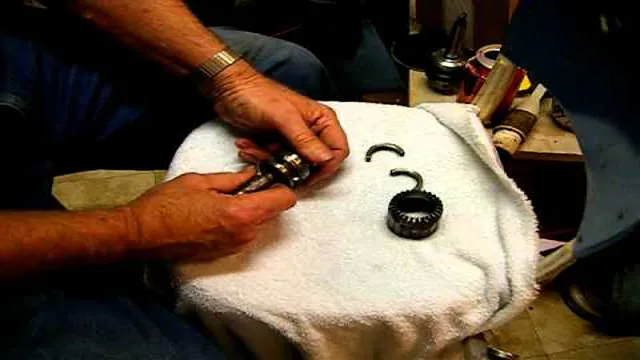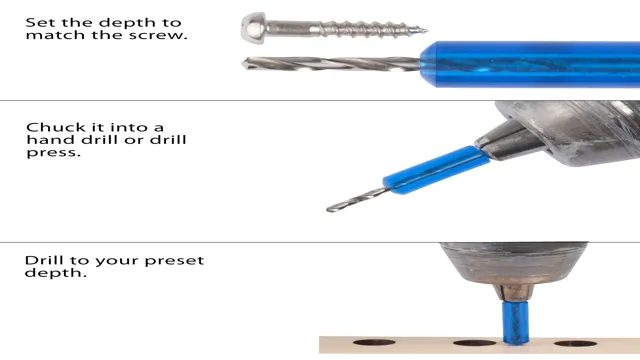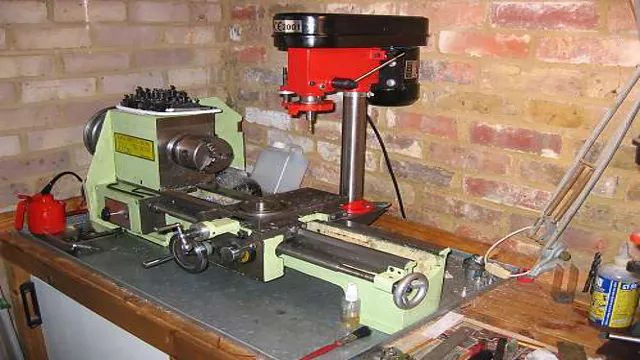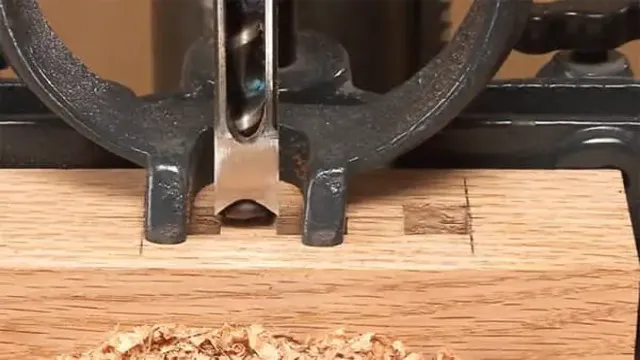How to Read a Drill Press Speed Chart: A Comprehensive Guide for Beginners
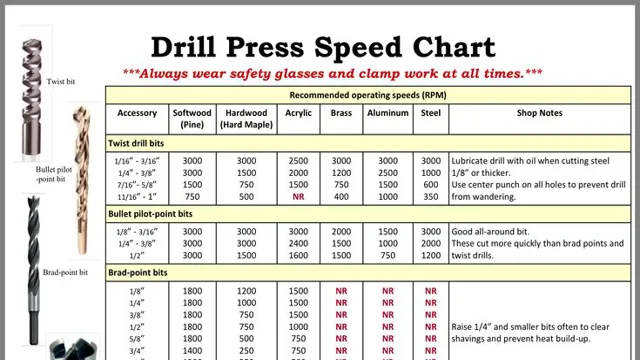
A drill press speed chart can be an invaluable resource for anyone who works with a drill press on a regular basis. But if you’re new to the game, the chart may seem confusing and overwhelming. With so many numbers and settings to choose from, how do you know which one is the right one for your task? Fear not, because we’ve got you covered.
In this blog post, we’ll break down how to read a drill press speed chart, so you can get the most out of your equipment and ensure a successful outcome every time.
What is a Drill Press Speed Chart?
If you want to get the most out of your drill press, understanding how to read a drill press speed chart is crucial. A drill press speed chart is a guide that shows you which spindle speed is best to use for a particular material, size of drill bit, and type of drill bit you plan to use. Most drill press speed charts organize the information in a table format that is easy to read and understand.
You’ll typically find a list of materials on one side and a corresponding range of speeds on the other side. Some drill press speed charts might include additional information such as feeds per minute and the recommended depth of cut. By using a drill press speed chart, you can help avoid damaging your drill bits, reduce the risk of overheating, and achieve a smoother, more efficient drilling experience.
Definition and Purpose of a Drill Press Chart
A drill press speed chart, also known as a drill press chart or speed reference chart, is a convenient and essential tool to help you determine the correct speed settings for your drill press based on the type of material you are drilling, the size of the drill bit, and the type of drill bit you are using. These charts provide a range of speed settings for different drill sizes, allowing you to select the appropriate speed for your drilling needs. The purpose of a drill press speed chart is to ensure that you are using the correct speed to achieve optimal results and to prevent damage to your drill press, the drill bit, and the material being drilled.
Using the wrong speed can cause problems such as overheating, dulling or breaking of the drill bit, and damage to the material being drilled. It’s worth noting that while drill press speed charts provide helpful guidance, they are not set in stone and can be adjusted depending on the unique circumstances of your project. As with any tool, proper use and caution are key, and it’s important to always follow the manufacturer’s instructions and guidelines for your specific drill press.
By utilizing a drill press speed chart, you can ensure that you are setting the correct speeds for your drilling needs and achieving the best possible results in your work.
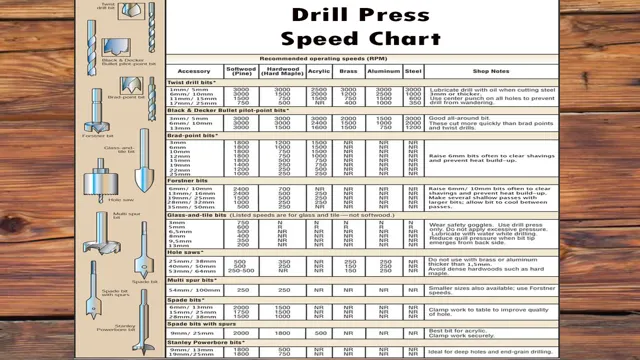
How to Interpret the Chart
A drill press speed chart is a chart that provides detailed information about the recommended speeds for drilling various materials using a drill press. This chart helps users get the best results based on the type of material they are working with. The chart shows the recommended speed settings for different types of bits, including spade bits, twist bits, and hole saws, and provides guidelines for selecting the proper speed based on the diameter of the bit.
Drilling at the correct speed can prevent damage to the bit and material and also help ensure a clean, precise cut. This chart can be useful for both beginners and experienced users of drill presses, as it provides dependable guidance to help achieve optimal results. So the next time you need to drill a hole, refer to the drill press speed chart to select the right speed setting for the job.
Types of Drill Press Speed Charts
If you own a drill press, you’ll inevitably need to understand how to read a drill press speed chart. A speed chart is a table that lists recommended speeds for drilling through different types of materials, such as wood, metal, and plastics. There are different types of speed charts available, with some charts providing a range of options for different drill bit sizes, while others offer general speed recommendations across all bits.
The type of chart you use will depend on your specific needs and the type of materials you plan to drill. When reading a speed chart, it’s important to note that the speed recommendation is based on the hardness and density of the material, as well as the size of the drill bit. Remember to always keep your safety in mind and wear the proper protective gear before starting your project.
With the right chart, you’ll be able to smoothly and accurately drill through your materials with ease.
Step Pulley Chart
When it comes to using a drill press, knowing the right speed to use can make a big difference in the success of your project. One type of speed chart commonly used is the step pulley chart. This chart shows the different speed options based on the pulley configuration of your drill press.
The chart typically includes the number of steps and the speed for each step. Some drill presses may have more steps than others, and the speed range can vary as well. It’s important to refer to the chart for your specific drill press to ensure you’re using the appropriate speed for the task at hand.
By using the step pulley chart, you can achieve a better-quality result and prevent damage or accidents that can occur when using the wrong speed. So next time you use a drill press, take a look at the step pulley chart and make sure you’re operating at the optimal speed.
Variable Speed Chart
Variable Speed Chart When it comes to drill press speed charts, there are two types commonly used. The first type is a chart that shows the recommended speed for each type of drill bit based on its diameter. This chart is helpful because it ensures that you’re using the correct speed for your bit, which can extend its lifespan and reduce the likelihood of overheating or binding.
The second type of speed chart is a variable speed chart which indicates the range of speeds available on your drill press. With a variable speed chart, you can adjust your drill press’s speed according to your needs, from a slow speed for tougher materials to a faster speed for lighter ones. This chart can be especially helpful when working with unfamiliar materials or when experimenting with different drilling techniques.
Overall, understanding the types of drill press speed charts available can help you maximize your drill press’s performance and lifespan. By using the right speed for each bit and adjusting your speed to match the material, you can achieve cleaner, more precise, and safer drilling results.
Direct Belt Drive Chart
When it comes to drill press speed charts, there are a few different types available depending on the drive system of the machine. One common type of chart is the direct belt drive chart. This chart provides guidance on the various speed settings that can be achieved through changing the position of the belts connected to the drill press motor.
Typically, these charts will include information on the recommended speeds for different types of materials and drilling operations, such as metal, wood, and plastics. Direct belt drive charts can be especially useful for those who frequently work with a variety of materials and need to adjust their drilling speed accordingly. By following the guidelines provided in the chart, you can ensure that you are using your drill press effectively and efficiently, while also extending the life of your equipment.
Factors to Consider When Using Drill Press Speed Chart
Understanding how to read a drill press speed chart is crucial for every woodworker or metalworker to obtain the best drilling results. The chart indicates the recommended spindle speed for drilling holes with different diameters and different materials. However, there are some factors that should be considered when using the chart.
Firstly, the material of the drill bit should be matched with the material of the workpiece to avoid overheating, which may cause the drill to dull or break. Secondly, the type of drilling operation such as drilling a straight or angled hole, and the depth of the hole, will require different speeds. Finally, the size of the drill bit and the horsepower of the drill press will also determine the optimal speed range for the job.
By taking these factors into account, you’ll be able to read the drill press speed chart effectively and achieve the best results with your drilling operations.
Drill Bit Size
When using a drill press, it’s important to take into account the recommended speed for the drill bit size and material you’re working with. Consult a drill press speed chart to determine the appropriate speed range to avoid damaging the bit or workpiece. But, it’s not just about blindly following the chart.
There are other factors to consider, such as the material you’re drilling through, the type of bit, and the depth of the hole. For example, drilling through harder materials may require a slower speed to prevent the bit from overheating and becoming dull. Conversely, drilling through softer materials may require a faster speed to prevent the bit from getting stuck or clogging.
Additionally, using the right lubricant can also extend the life of your drill bit. So before you power up your drill press, take the time to consider all the factors at play to ensure a successful and efficient outcome.
Material being Drilled
When using a drill press, it’s important to consider the material being drilled in order to determine the appropriate speed to use. Different materials require different speeds to avoid overheating or fracturing the material. For instance, hardwoods require slower speeds while softer materials like plastics and aluminum can handle faster speeds.
It’s also important to consider the size of the drill bit being used. Smaller bits require faster speeds, while larger bits require slower speeds to avoid breaking. Using a drill press speed chart can help guide you in determining the appropriate speed for the material and bit size.
By taking these factors into consideration, you can ensure a successful drilling experience without damaging the material or your equipment.
Type of Drill Bit
When it comes to using a drill press speed chart, it is important to consider several factors, including the type of drill bit you are using. Different materials and sizes of drill bits require different speeds to perform optimally, so it is important to consult the manufacturer’s guidelines or a comprehensive chart for guidance. Additionally, the material being drilled and the thickness of the material can also affect the optimal speed for your drill press.
For example, drilling through metal may require a slower speed than drilling through wood. By carefully considering the type of drill bit and material being used, as well as following safety guidelines, you can ensure a successful and efficient drilling experience. So next time you’re using a drill press, be sure to consult a speed chart and adjust the speed accordingly to achieve great results.
Conclusion
Congratulations, you now understand how to read a drill press speed chart! Never again will you have to guess what speed to set your drill to, or risk damaging your material with the wrong speed. Just remember to always check the material you’re drilling and the size of the bit you’re using, and adjust your speed accordingly. Reading a drill press speed chart may seem daunting at first, but with practice, it becomes as simple as a game of connect-the-dots.
So, go ahead and let your drilling prowess shine – with the power of a well-read speed chart at your fingertips, the sky’s the limit! Happy drilling!”
FAQs
What is a drill press speed chart?
A drill press speed chart is a table that shows the recommended speed settings for various drill bit sizes and materials.
How do I read a drill press speed chart?
To read a drill press speed chart, locate the size and material of the drill bit you will be using, then follow the corresponding column to find the recommended speed setting for your drill press.
Why is it important to use the correct speed setting on a drill press?
Using the correct speed setting on a drill press is important to ensure optimal performance and avoid damage to the drill bit and workpiece.
What happens if I use the wrong speed setting on a drill press?
Using the wrong speed setting on a drill press can cause the bit to overheat, dull prematurely, break, or cause damage to the workpiece.
How do I select the correct drill bit for my project?
When selecting a drill bit, consider the material of the workpiece and the size hole you need to create. Different drill bit materials and sizes are suited for different types of projects.
Can I use the same speed setting for all drill bits?
No, different drill bit sizes and materials require different speed settings. It is important to consult a drill press speed chart and select the appropriate speed setting for each drill bit.
Can I adjust the speed setting while the drill press is running?
No, it is not recommended to adjust the speed setting while the drill press is running. Always turn off the drill press and adjust the speed setting before beginning a new project.

